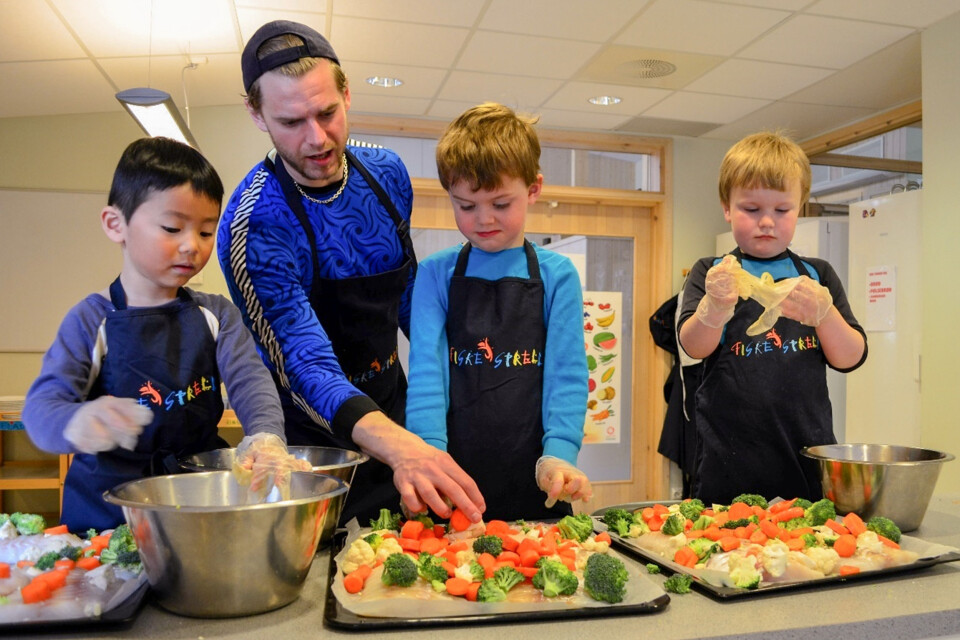
Bring the boys into the kitchen!
Boys are less involved in the preparation of food than girls are, according to a survey Nofima carried out among preschool children. If boys are encouraged to cook or prepare food more often, it can help improve equality and public health in a dietary perspective in the future.
An article in the journal Public Health Nutrition states that people who feel confident about their cooking skills cook for their family more often, and their food often has a healthier nutritional content than food served by persons who feel that they are bad at cooking. In addition, research shows that those who learn to cook while they are children or adolescents are usually more confident about their cooking skills than others.
Teaching children to cook healthy dishes containing seafood and vegetables can therefore be a smart strategy for increasing their intake of such foods.
Children like food more if they make it themselves
Several studies show that today’s parents teach their children to cook to a lesser degree than what was the case in previous generations. This places an extra responsibility on kindergartens, preschools and schools.
In the Nofima survey ”Fish chefs of the Future” – we looked into whether kindergarten children who were allowed to take part in preparing a fish dish liked the food better than children who were served the same dish by the kindergarten staff – without taking part in the preparation if it. 25 children aged 4-5 years from three preschools in Tromsø participated in the study. Nine of the children prepared a seafood dish with fish fingers, mashed potatoes and root vegetables.
The results indicated that the children who took part in the preparation of the food liked the ingredients better than the children who only had the dish served by the staff.
Children don’t cook at home
The children’s parents also completed a survey about how often the child took part in food-related activities at home, such as cooking, frying or baking food, making open sandwiches or cutting, chopping and peeling food.
The results show that the children rarely took part in activities where they were in direct contact with the food. The most common activity was to set the table and decide what they were going to have for dinner.
Since the children were four and five years old, it was not surprising that only a few of them had tried boiling or frying food. Still, it was clear that the girls made their own open sandwiches and helped chop vegetables more often than the boys.
Kindergartens and preschools should take responsibility
The interviews we did with the staff responsible for food and nutrition in the kindergartens showed that the involvement of children in the kitchen was often done without any pedagogical or strategic anchoring.
It was usually the girls who volunteered when the children were asked if they wanted to help prepare food. The boys would rather be outside playing or doing other things. This indicates that cooking was not considered to be a pedagogical activity which should be equal for all children, and that they had a rather haphazard approach to determining who should be allowed to learn basic cooking skills.
The results indicate that kindergartens and preschools should be more conscious about including boys in food-related tasks, since they also do not often participate in these activities at home. This could help increase the preference for healthy foods among both girls and boys, and improve their diet and eating habits as adults.
Higher expectations of the mother than the father
In families where both the mother and father work full-time, and consider themselves to be in an equal relationship, the mother nonetheless assumes the main responsibility for the children and cooking at home, according to a doctoral thesis in sociology.
The serving of meals at home involves activities such as planning, purchasing, preparation, tidying and dishwashing, and thus constitutes a considerable burden if it is mainly carried out by one person.
If we do not adopt a more conscious strategy about teaching boys to cook as well, we will only continue the traditional gender role pattern.
And so I say: Bring the boys into the kitchen! After all, they will be the fathers of the future. They can take a greater part in common household chores compared to many of today’s fathers.







